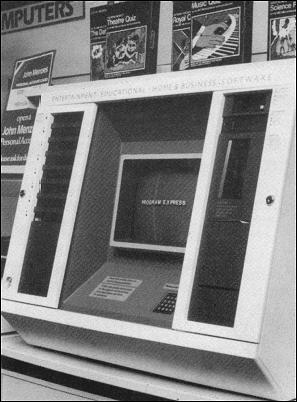| Sinclairvoyance |
IT SEEMS that almost every day another major chain of high street stores enters the computer market. The latest of these is Marks and Spencer, renowned for its lines of durable Y-fronts and sensible sweaters. The more outlets there are for micro products, the better it is for the user, or so the argument goes. There is, however, dissatisfaction amongst consumers and manufacturers with the service provided by the main street middlemen.
The trade paper Home Computer Trade Weekly recently conducted a spot survey of seven retail chains and the signs are not encouraging.
It is no surprise that top of the pops is WH Smith which gets good ratings for floor space, trained staff, software range and layout. It does not, however, score highly where new products are concerned, and that is a fault with all retailers who stock old ranges until they have been cleared off the shelves. Both customer and software house suffers as a result because new products are not generally available. It is not surprising that publishers have complained of disastrous sales this summer when shop shelves are stocked with dusty copies of Maziacs and Mad Martha.

The amount of shelf space is itself a problem and one which is tied in with floor space given to a computer department. Again WH Smith comes top and Rumbelows comes bottom in the CTW report. In most outlets software is put at the back of the shop where few people can see it and is given little shelf space. Frequently it is displayed inside the forbidding glass cabinets, a discouragement to browsing customers. The display can be confusing, with Spectrum software jumbled up with VIC 20 and Commodore cassettes, under the misleading sign reading 'Atari', or even 'Computer Books'. Cut-price Mastertronic tapes stand shoulder-to-shoulder with full-priced Virgin games, and the price of a particular item can vary on different shelves in the same shop.
Finding software and getting technical help is frustrating for the potential customer. Few chain stores train staff to handle computer buff's and some staff are transferred from other departments to work with computers without having the slightest idea of what a computer can be used for. Those assistants are good at handling merchandise but when it comes to providing information about it they are lost. When in doubt, the answer is "It's out of stock".
WH Smith give the best training of all the computer retail stores and Currys is about to give its staff some help by sending them on courses. Those will take place at Currys training establishment at Worthy Park. The company hopes to turn out computer consultants which it will distribute among 90 of its top computer stores. The consultants should be able to talk about the market, advise which software and machines to buy and how to program.
The identification by Currys of the need for trained consultants in its stores shows that some movement is being made toward market maturity, although chain stores still have a long way to go.
The problems are not only concerned with software distribution and retailing. Readers of Sinclair User have experienced difficulty in buying machines and hardware add-ons. One reader had difficulty in obtaining a complete printer package for his Spectrum. He tried Boots, Laskys, Dixons and a back street computer shop before going to a mail order company. That company, Transform, delivered printer, leads and interface on the day that the order was confirmed. If shops are going to carry printers or computers who not stock the necessary interfaces between the two?
Discs and printer ribbons are notoriously difficult to obtain off the shelf even from the same shops that supply the disc units or printers. One Sinclair User staff member bought a printer at Dixons and was told, "Sorry, we don't have any spare ribbons for that printer". WH Smith was no more helpful, Boots had never heard of the printer and Laskys said that one was on order.
A solution to the hardware problem might be elusive but the answer to software availability may be near with the introduction into John Menzies of a system of electronic distribution by a company called Program Express.
Shops using the system each have a computer terminal linked to a mainframe at a computer centre. When a customer wants a particular program the assistant selects the program required. The mainframe can hold 1000 programs at a time and those are updated regularly. The machine downloads the selected program onto disc, tape or ROM cartridge and it can then be taken away.
The retailer would never again have any difficulty in finding or stocking a piece of software. Mind you, the distributors might complain. There would be less need for their services in a world in which software is on tap in the high street.
John Gilbert